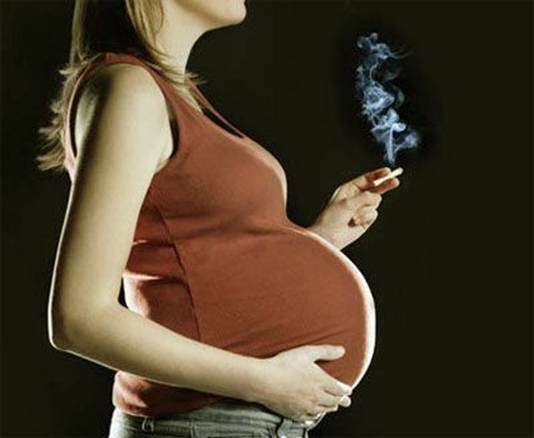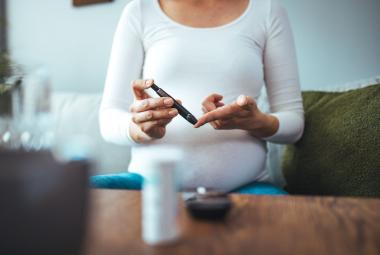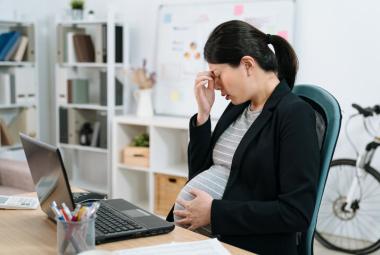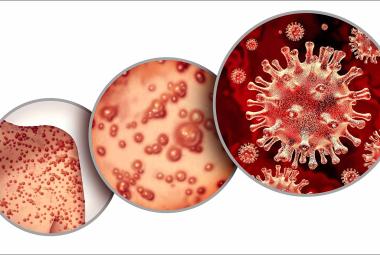Tobacco use during pregnancy is the most important modifiable risk factor associated with adverse pregnancy outcomes. Research has shown that smoking during pregnancy causes many health problems for both mothers and babies, such as infertility, placental rupture, abnormal placental implantation, preterm premature rupture of membrane (PPROM) or early rupture of the amniotic sac membrane, premature birth, stillbirth, low-birth-weight infant, and sudden infant death syndrome (SIDS).1, 2
In 2010, the Pregnancy Risk Assessment Monitoring System (PRAMS) survey found that 11 percent of pregnant women smoke during the last three months of pregnancy.3 Prevalence varies based on the method of data collection including location, ethnicity, age, education and health coverage with the highest numbers of following: 30.5 percent in West Virginia, 26 percent in American Indians/Alaska Natives, 17.6 percent in women aged 20 to 24 years, 17.4 percent in women < 12 years of education, and 17.6 in women with Medicaid coverage during pregnancy or delivery.2
Not only does tobacco smoking cause cancer, premature aging, stroke, lung disease, heart disease, hypertension, and asthma exacerbations, tobacco exposure is especially dangerous for pregnant or breastfeeding mothers. Tobacco is smoked in the form of cigarettes, cigars, pipes, and waterpipes. In addition, it is chewed in the form of snuff and is absorbed through buccal mucosal membrane.4 Tobacco products are made from leaves of a plant called Nicotiana tabacum, from whose plant family many drugs, poisons, and spices come from. Centers for Disease Control and Prevention (CDC) has reported that tobacco smoke contains more than 7,000 chemicals, hundreds of which are toxic like cyanide, lead, nicotine, carbon monoxide, and about 70 cancer-causing compounds. Through smoking, these harmful chemicals can transfer into the pregnant mother’s blood stream: the fetus’ only source of oxygen and nutrients.
Two particular compounds are especially harmful: nicotine and carbon monoxide, both of which cross the placenta. While nicotine acts as a stimulant in the central and peripheral nervous system of people and other mammals, it obstructs oxygen delivery by narrowing blood vessels throughout the body, including the ones in the umbilical cord.2, 5 In addition, the red blood cells become filled with carboxyhemoglobin, which further diminishes tissue oxygenation. Ultimately, impaired fetal oxygen delivery results in devastating effects on the baby’s growth and development. Furthermore, smoking may also result in direct damage to fetal genetic material6, impaired lung development7, acceleration of fetal heart rate and a reduction in fetal breathing movement.2, 8
Not only does active smoking cause risks but also involuntary exposure to tobacco smoke such as secondhand and thirdhand smoking are harmful to pregnant women as well. Secondhand smoke (SHS), or environmental tobacco smoke, is a mixture of sidestream smoke given off by smoldering tobacco and the mainstream smoke that is exhaled back into the air by active smokers. Exposure to SHS can be estimated by measuring concentrations of smoke components in the air, or in the form of biomarkers such as cotinine.9
Mayo Clinic has stated that nonsmoking women who are exposed to secondhand smoke are at increased risk of pregnancy loss or having a baby who has birth defects or a low birth weight. Furthermore, in an International Consultation on Environmental Tobacco Smoke and Child Health Report,the World Health Organization has stated that exposure to SHS associated with many adverse health effects in children, including prematurity, perinatal mortality, SIDS, asthma, middle ear disease, and future risk of heart and kidney diseases.9, 10
Thirdhand smoke (THS) consists of smoke components deposited on surfaces like clothes, furniture, carpet, walls, and hair. THS is a potential health threat to children, spouses of smokers and workers in environments where smoking has been allowed. Upon chronic exposure, THS toxins age over time scales ranging from seconds to months, progressively forming toxic carcinogens.11 Then, these smoke toxicants can be ingested orally, inhaled through lung, and absorbed through skin. A study using an animal model exposed to THS under conditions that mimic exposure of humans suggests there are adverse effects of THS on liver, lung, skin healing, and behavior.In this study, THS delayed wound healing, increased hyperactivity on behavior tests, increased non-alcoholic fatty liver disease predisposing cirrhosis and cancer in liver, and stimulated excess collagen and cytokines production in lungs emulating inflammation-induced diseases such as COPD or asthma.12
The negative impact of cigarette smoking on fetal health is well established. Although smoking cessation during pregnancy is of maximal benefit if it occurs early in the first trimester, quitting at any time during pregnancy can have some beneficial effects.13 Women are more likely to be successful if encouraged to quit, rather than cut down. For women who are heavy smokers and are unable to quit on their own, pharmacotherapy is recommended. Both nicotine replacement therapy and bupropion are first-line drug options.2 In addition, a randomized trial that compared e-cigarettes with nicotine patches suggests that e-cigarettes might have the potential to be smoking cessation aids among smokers who wanted to quit. However, further studies will be required to establish the efficacy and safety of e-cigarettes for cessation.4, 14
Since there are no risk-free exposure levels of SHS and THS, the Surgeon General has concluded that the only approach that effectively protects nonsmokers is to make a 100% smoke-free environment.15 Opening a window, sitting in a separate area, or using ventilation, air conditioning, or a fan cannot eliminate secondhand smoke exposure. However, American Cancer Society has stated that nonsmokers can protect themselves and their loved ones by making their homes, cars, workplaces, and public places smoke-free: asking people not to smoke around them, making sure that their children’s day care center or school are smoke-free, and choosing smoke-free restaurants and other businesses. In addition, they should teach children to stay away from SHS.15
Postpartum relapse is a significant problem, with about 50 percent of quitters relapsing in the first two months after delivery. These women should be considered "at risk" and provided with ongoing support.2 If the mother does continue to smoke after giving birth, however, it is still more beneficial to breastfeed than to completely avoid this practice altogether. There is evidence that breastfeeding offers protection against many infectious diseases, especially diarrhea. Even in babies exposed to the harmful effects of nicotine through breast milk, the likelihood of acute respiratory illness is significantly diminished when compared to infants who were formula fed and whose mothers smoked. Regardless, the benefits of breastfeeding outweigh the risks of nicotine exposure.15
Lylla Ngo, MD
James Abbey, MD
References:
1. DeCherney AH. Current diagnosis & treatment : obstetrics & gynecology. 11th ed. ed. New York: McGraw-Hill/Medical; 2013.
2. Rodriguez-Thompson D. Cigarette smoking and pregnancy. UpToDate; 2014.
3. Tong VT, Dietz PM, Morrow B, et al. Trends in smoking before, during, and after pregnancy--Pregnancy Risk Assessment Monitoring System, United States, 40 sites, 2000-2010. MMWR Surveill Summ. Nov 8 2013;62(6):1-19.
4. Rigotti N, Rennard S, Daughton D. Patterns of tobacco use. UpToDate; 2014.
5. Burton GJ, Palmer ME, Dalton KJ. Morphometric differences between the placental vasculature of non-smokers, smokers and ex-smokers. Br J Obstet Gynaecol. Aug 1989;96(8):907-915.
6. de la Chica RA, Ribas I, Giraldo J, Egozcue J, Fuster C. Chromosomal instability in amniocytes from fetuses of mothers who smoke. JAMA. Mar 9 2005;293(10):1212-1222.
7. Sekhon HS, Keller JA, Benowitz NL, Spindel ER. Prenatal nicotine exposure alters pulmonary function in newborn rhesus monkeys. Am J Respir Crit Care Med. Sep 15 2001;164(6):989-994.
8. Sherman J, Young A, Sherman MP, Collazo C, Bernert JT. Prenatal smoking and alterations in newborn heart rate during transition. J Obstet Gynecol Neonatal Nurs. Nov-Dec 2002;31(6):680-687.
9. Samet J, Sockrider M. Secondhand smoke exposure: Effects in children. UpToDate; 2014.
10. International Consultation on Environmental Tobacco Smoke (ETS) and Child Health: World Health Organization; 1999.
11. Matt GE, Quintana PJ, Destaillats H, et al. Thirdhand tobacco smoke: emerging evidence and arguments for a multidisciplinary research agenda. Environ Health Perspect. Sep 2011;119(9):1218-1226.
12. Martins-Green M, Adhami N, Frankos M, et al. Cigarette smoke toxins deposited on surfaces: implications for human health. PLoS One. 2014;9(1):e86391.
13. Rigotti N. Benefits and risks of smoking cessation. UpToDate; 2014.
14. Bullen C, Howe C, Laugesen M, et al. Electronic cigarettes for smoking cessation: a randomised controlled trial. Lancet. Nov 16 2013;382(9905):1629-1637.
15. Samet J, Sockrider M. Control of secondhand smoke exposure. UpToDate; 2014.







